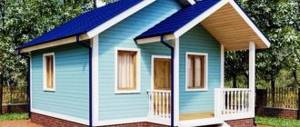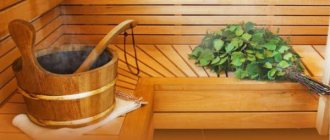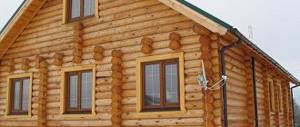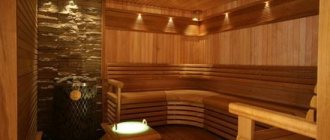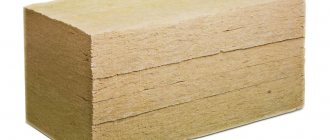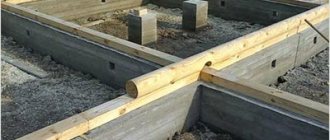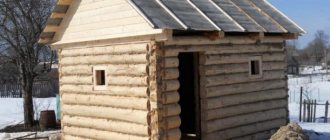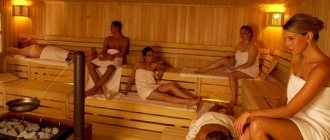As you know, there are no trifles in a bathhouse, so every detail should be given the closest attention. For example, if during construction you have perfectly insulated the floors in all rooms, installed a heating system and covered the surface with ceramic tiles, you should take care of the comfort of movement.
After all, as you know, wet ceramics are very slippery, which can lead to falls and injuries. To avoid this, bath ladders are used. But their scope of application is not limited to this; they can also be used as the main floor covering, but more on that below.
>
In the photo - a section of the bathhouse ladder
Requirements
Despite the simplicity of the design, do-it-yourself bathhouse floor gratings must be made correctly. The following factors need to be taken into account:
- Safety. The gaps between the slats should be of such a size that children do not fall between them, and injuries to the toes should also be avoided if they fall into these gaps. This is ensured by the correct choice of gap width. In addition, the platform must be stable and not tip over if you carelessly press on its edge. The surface of the beams must be well processed to prevent splinters, and the connecting elements (screws, nails) are buried in the material.
- Reliability. An important condition is sufficient mechanical strength. The platform must be able to support the body weight of an overweight person. The material is selected without cracks or chips.
- Sanitary standards. When exposed to extreme temperatures in the steam room, the grate material should not emit substances harmful to the human body. The presence of rot and mold is unacceptable.
- Specific requirements. Water should flow freely through the gaps without accumulating on the surface of the site. The height of the grille must provide all the functions of the structure. To ensure sanitary standards, the material is impregnated with an antiseptic agent.
- Appearance. Even a small element, executed sloppily, can ruin the entire bath interior. Grids should not be unnecessarily bulky. During production, external perception should be taken into account. Often, to create a special interior, not just parallel laying of external planks is used, but their figured arrangement.
Conclusion
We hope that our brief instructions will help you choose high-quality drains for your bathhouse without extra costs or outside help. These simple designs have both a practical meaning, preventing accidents and allowing water to flow freely into the sauna drain, and an aesthetic one - the wood fits perfectly into the interior.
You can also make furniture for a bathhouse that matches the style of the ladders on the floor
In addition, wood is an environmentally friendly material that does not contain chemical compounds harmful to the human body. And some types of wood, when exposed to temperature, release beneficial substances into the air, making the atmosphere in the bathhouse even more favorable. The video in this article will help you understand this topic more clearly.
Did you like the article? Subscribe to our Yandex.Zen channel
Manufacturing Features
You can make a grate for the floor of a bathhouse with your own hands. The work will be carried out in several stages:
- Preparatory. A design diagram is drawn, i.e. The required size and number of required flooring boards are determined. The standard platform has dimensions of 60x60 cm. Based on these conditions, the number of boards required is 4 pieces, the gap is 2.5 mm, and the boards should be 12.5 cm wide. 4 boards are cut 60 cm long. The base is made of 50x50 timber mm. For it, 2 bars 58 cm long are cut. All elements are carefully processed with a plane and emery cloth.
- Assembly of the structure. The base bars are laid parallel to each other so that the distance between their outer edges is 58 cm. The flooring boards are attached to the bars, and they should protrude from their edge and end by 1 cm, fixed perpendicular to the bars and strictly parallel to each other with a gap of 2.5 cm. Fastening is done with screws, their heads must be recessed into the wood. To do this, it is advisable to pre-drill a hole at the mounting location.
- Final activities. To increase the reliability and practicality of the grille, the following work is carried out: all wooden parts are impregnated with an antiseptic composition using a paint brush, which will protect the wood from rotting. In practice, oil is often used for this purpose. To prevent the platform from sliding on a slippery bath floor, it is recommended to secure rubber feet (gaskets) at the bottom.
On a note! When assembling a bath grate with your own hands, you should take care of the tools in advance.
You need to prepare an electric drill, a plane, a screwdriver, a hacksaw, a paint brush, a metal ruler, a tape measure, clamps or a vice, a file, and sandpaper.
Types of materials from which it is made
In our articles, we constantly remind you that a bathhouse is a concentration of only natural, environmentally friendly natural materials, and the hero of our conversation today is no exception.
Wool rugs
Wool products have been known for a very long time. And they enjoy well-deserved popularity, largely due to the set of unique properties inherent in animal fur:
- Wool fibers enhance blood microcirculation, and the wax that covers the spine has an extremely beneficial effect on the skin epithelium. Thus, woolen products can and should be used as items for delicate massage and therapeutic agents;
- The thermal conductivity of wool is very low, therefore, such a rug can be successfully used as a heat-resistant bedding when taking procedures in high-temperature saunas;
- Such items create a wonderful atmosphere in the bathhouse, organically complementing its interior.
Important! Obviously, it is especially worth noting the fact that wool products require detailed and careful care. So, they need to be thoroughly dried, periodically inspected for the presence of insect pests, and exposed to direct sunlight from time to time. In the end, it should be noted that natural sheepskin is quite expensive and it is worth purchasing only well-dressed skins by a professional furrier.
Felt rugs
Since ancient times, nomads have equipped their homes with felt, noting that this material perfectly functions as insulation, insulates extraneous sounds well and, most importantly, perfectly regulates the microclimate in the room, absorbing excess moisture and releasing it as needed. This feature is not bad to use in a bathhouse. Among other things, it has long been practiced to treat old wounds, fractures, and overstrain of the lower extremities with felt. The therapeutic effect is associated primarily with the content of lanolin in the felt fabric.
Application of purchased gratings
When you need a ready-made grate for the floor of a bathhouse, you can buy it on the market, in specialized and hardware stores, or online. It is important to correctly determine the required size and shape of the site. Nowadays, the choice of such products is very wide - from cheap simple gratings to decorative products made of mahogany. It all depends on the imagination and financial capabilities of the owner.
On a note! In addition to wooden structures, plastic bath grates have become quite popular.
Such finished products should not be used in the steam room, but they are quite suitable for the washing compartment and dressing room. Platforms made of polyvinyl chloride and acrylonitrile butadiene styrene are widely used. The latter option has increased resistance to aggressive environments and temperature changes, and at the same time has high mechanical abrasion resistance.
A grate on the floor of a bathhouse sometimes solves the problem of insulation and increases the convenience of the bathing procedure. This method has been used in Russian baths and saunas for a long time, and in our time we should not forget about it. A simple device you can easily make with your own hands.
What is a rug for?
In general, the purpose of this accessory can be divided into three large groups:
- Hygienic. As you know, high humidity and heat are a very favorable environment for the development of pathogenic microflora. This is especially obvious for public baths, through which a lot of people of different social classes with different levels of health pass. The mat, like a substrate, when in contact with bath surfaces, will pose a serious barrier to pathogenic microorganisms and will help make visiting a bathhouse, primarily a public one, safer.
- Applied. A sauna mat serves as a barrier when the body comes into contact with the surfaces of a lean room heated to high temperatures. In Europe, and recently in our country, they have been quite successful in fighting open body burns in a sauna with the targeted use of special wood with a low coefficient of specific heat capacity. One of the leaders in the fight against high temperatures is the African maple - abash. But products made from it are expensive, and re-equipping the steam room also costs a lot.
- Therapeutic. A bath mat, expertly made from natural materials of natural origin, can make a significant contribution to the prevention and treatment of a fairly wide range of diseases. We will talk about the principles of health-improving use in more detail below.
Cork flooring for baths
Cork flooring materials are the most controversial type of covering. They raise many questions and often even controversy. Some argue that such floors are convenient and comfortable, others say that they have more disadvantages than advantages. Nevertheless, the floors are covered with cork, and this is also done in the baths, including in its wet rooms - the shower and steam room.
Cork has long provided humanity with high-quality, recyclable material. One of the areas of its application is the creation of elastic, durable and resilient panels (both decorative and technical properties), which are used in the finishing of walls and floors, and construction.
Cork is unusually light, durable, elastic and resilient. The exceptional properties of a material are determined by its structure. The structure of the cork is similar to a honeycomb of millions of multilayer cells impenetrable to water and filled with a gaseous mixture of nitrogen and oxygen.
Cork coverings, as a natural antistatic agent, do not electrify, which means they do not collect dust and have excellent anti-allergic properties. In addition, cork does not rot, does not rot, is invulnerable to mold, does not emit harmful substances, and does not support combustion. In addition, manufacturers provide the consumer with a fairly wide selection of decorative textures.
Now let's talk about those properties of cork that cause criticism. Firstly, it is permeable. Manufacturers claim that the properties of cork allow it to restore its original appearance even after significant pressure (for example, by the leg of a chair, cabinet, or the heel of a shoe). However, the practice of using such coatings suggests that most often such dents are not restored. In order to avoid their appearance, it is better to “shod” furniture legs in felt slippers. And when using cork flooring in the kitchen, it is better to lay tiles under the cabinets.
Read: Sauna in the apartment
Another unpleasant thing that we often hear from owners of cork floors is that because of their roughness, socks in which adults and children walk on the floor quickly wear out and even injure their feet. In addition, due to the same roughness, such a floor is difficult to wash. This is indeed possible. To avoid this, the floor must be properly prepared, and the cork itself must be varnished, and this must be done with intermediate sanding. It is better to varnish a sanded cork with a velor roller in three layers, and with a factory prevarnish in two. The frequency of varnishing is every 5-6 years, you can varnish earlier.
If the base of the floor has even minor defects, the cork coating will not only not hide them, but over time the coating itself will deform in these places.
Cork is an excellent material, durable, “warm”, perfect for families with small children constantly crawling on the floor, however, all these qualities are fully manifested if the installation work is carried out professionally. However, a similar statement is true for any finishing material.
TYPES OF CORK FLOOR COVERINGS
There are two types of cork flooring: adhesive and interlocking. In the case of baths, the first option is preferable, since it forms a continuous coating. Even in the event of a small flood, such a floor will be able to retain moisture and prevent it from penetrating under the substrate. In addition, if everything is done correctly, cracks will not form between the tiles over time, and in the case of interlocking (floating) floors, this is quite possible, especially if the floor was laid in hot weather.
Read: Laminate laying technology
Adhesive flooring consists of square or rectangular sandwich boards based on pressed cork. The front side of the panels is covered with cork veneer and a layer of polyvinyl. Various colors are possible, including marbled. Applying varnish after laying the coating guarantees more reliable operation of the cork floor. This is important in every sense. If the varnish coating is weak, unreliable or absent altogether, then the cork floor can deteriorate significantly over time, especially in a house where there are animals (large, ill-mannered puppies or cats). Therefore, varnish for such a floor must be chosen only of high quality.
Often, adhesive floors have a chamfer, which allows you to form a unique pattern on the floor. You can set the direction with a chamfer, lay it diagonally, across the room, or make a complex geometric pattern. Thus, the presence of a chamfer is quite justified from an aesthetic point of view, but not so much from a practical point of view.
Interlocking floor cork, also called cork laminate or floating floor, is a three-layer panel in which the top layer of decorative cork is located on a layer of HDF base with interlocking fastening around the perimeter (like a laminate), and the third, lower layer acts as a damping cork substrates. This parquet got its name “floating” due to its specific installation – without glue. The coating is laid using a “lock”: each plate has protrusions and grooves on the sides, which are connected to each other during installation. That is why the installation of “floating parquet” does not require the use of glue.
It is better to install interlocking floor coverings in bathhouses in completely dry areas, for example, in the rest room. Where water can get on them, the coating may become deformed.
Read: Raised floor - modern technology for indoor flooring
CORK AGGLOMERATE
Among modern materials based on cork, cork agglomerate has proven itself to be excellent, which is used primarily for heat and sound insulation of rooms, but due to its properties it is also excellent as a floor covering in a bathhouse.
There are two types of cork agglomerates: pure and compound. They are also called black and white, respectively. White agglomerates are used mainly as finishing materials, as well as all kinds of technical substrates, gaskets, etc. Black agglomerates are used exclusively for insulation. They are darker (almost black) so they are easy to distinguish.
White agglomerate is ideal for decorating rooms, including as a flooring material. It does not require additional coverage.
This floor has excellent technical characteristics:
- high sound absorption coefficient;
- fire resistance class M3;
- density 100-130 kg/cm³;
- humidity does not exceed 7%;
- size change – no more than 03%.
The density of the agglomerate is less than that of solid cork. Consequently, the thermal conductivity of the final material becomes even lower.
The maximum temperature for using cork agglomerate is +130° C. and the minimum is not limited. It is also important to note that cork agglomerate is a fire-resistant material. It burns only when exposed to external influences, without releasing toxic substances.
White cork agglomerate is produced in the form of slabs with dimensions: 915 mm by 610 mm and 935 by 640 mm. The slabs have different thicknesses.
You might be interested in:
- Cork flooring: application, types, advantages
- Features of cork flooring
- Cork flooring
- Features of porcelain stoneware floors
- Environmentally friendly insulation based on natural materials
- “Warm floor” is not against laying linoleum
Subscribe to our channel in Yandex.Zen

